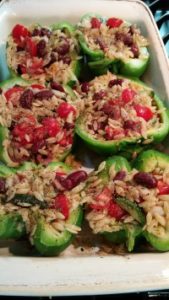
Canning and Freezing Make Foods Safe to Store
Way back in history, foods were preserved to keep them safe for us to eat. Two examples are canned and frozen foods which I cannot imagine being without in a 21st Century, healthy kitchen. Most of us have canned and frozen foods on hand at all times and we more-or-less take them for granted. Read on for tips about what exactly to stock in your healthy kitchen. Also, learn 3 examples of how to use modern canned and frozen foods to whip up easier and quicker classic recipes that taste great and are good for you.
How to Stock Up on the Right Stuff
Stocking up with foods that will serve as your healthy ingredients and those you use most is the best strategy since you’ll want to actively rotate your cans/frozen. A canned food has a shelf life of 6-12 months and a frozen food, depending what it is, can last for 3-6 months at top quality. Be sure not to buy too much and then let it sit in the pantry or freezer for too long. A list of pantry and freezer inventory can help with staying organized on this.
- Here’s a short list of cans for a healthy pantry: tomatoes, tomato paste, chick peas or black beans or kidney beans, tuna/salmon/sardines, artichokes, olives, solid pack pumpkin, no sugar added applesauce, pineapple in juice
- Here’s a short list of frozen foods for a healthy freezer: plain vegetables like broccoli/green beans/cauliflower/spinach, plain fruit like strawberries and raspberries, brown rice and/or quinoa, chicken without skin, salmon, extra lean beef and/or pork
How and Why Canned and Frozen Foods Help Modern Cooks
One big bonus of using canned and frozen foods is saving you time to cook a homemade meal. The contents of a can, after all, have already been cooked by the manufacturer so all you need to do is open the can. The contents of a simple frozen food pouch have been partly-cooked. With frozen vegetables, the blanching process is a safety step taken by the manufacturer that cuts cooking time by about one half. Another big bonus is the extended shelf life of canned and frozen foods way beyond storing them at room temperature or in the fridge. This convenience is super helpful when you want to stay flexible with meal planning and waste less. Saving you money on the grocery bill is a final big bonus. Canned and frozen foods have more stable and lower prices than foods like fresh fruits, vegetables, chicken, fish, and meat.
3 Quick and Easy Recipes with Canned and Frozen Foods
Putting your canned pantry and freezer to work is a smart approach and here are 3 ideas to get you cooking with a delicious, homemade result:
Stuffed Peppers – Use a frozen grain/veg product. See photo.
- Wash and cut peppers. Discard inside white parts. Place in baking pan.
- Stuff inside of peppers with a thawed, frozen mix of brown rice/veg or quinoa/veg.
- Pour about ¾ cup tomato juice into pan, surrounding peppers.
- Cover pan with aluminum foil.
- Bake at 400 degrees for 45 min. About 10 min. before peppers are cooked, open and sprinkle each pepper with 1 tablespoon grated Parmesan cheese.
Homemade Hummus and Vegetables – Use canned chickpeas, also called garbanzo beans.
Recipe details are here. Dip with crisp vegetables: celery, carrots, Bell pepper sticks.
Versatile Italian Sauce – Use canned, crushed tomatoes
Making Cans and the Freezer an Every Day Resource
There are hundreds of canned/frozen items that will make a quick and affordable meal. So, what are you waiting for? Do a pantry clean-out and then get organized for the staple, canned products you want to keep on hand all the time. Same with the freezer, do a clean-out and then re-stock with a good nutrition plan. I offer free Mediterranean menus with handy recipes as a jumping off point for your healthier kitchen, too.
What are a few of your go-to canned and frozen foods?